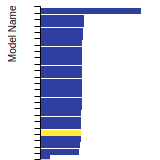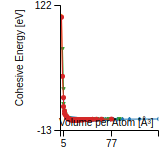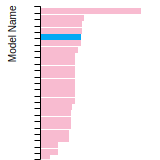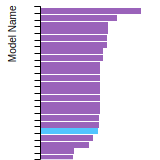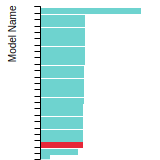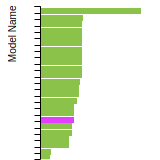 EAM_Dynamo_WilsonMendelev_2016_Mg__MO_574574915905_000
EAM_Dynamo_WilsonMendelev_2016_Mg__MO_574574915905_000
| Title
A single sentence description.
|
Finnis-Sinclair potential (LAMMPS cubic hermite tabulation) for Mg developed by Wilson and Mendelev (2016) v000 |
|---|---|
| Description
A short description of the Model describing its key features including for example: type of model (pair potential, 3-body potential, EAM, etc.), modeled species (Ac, Ag, ..., Zr), intended purpose, origin, and so on.
|
Finnis-Sinclair potential for Mg developed by Wilson and Mendelev (2016) in EAM format. According to the NIST IPRP, this potential is a variant of an older potential by Sun, Mendelev, Becker et al. (2006) (available in OpenKIM, see https://openkim.org/cite/MO_988004265451_000), except that the free surface energy was increased. (It was too small in the original potential which led to spontaneous cavitation in molecular dynamics simulations of the liquid phase.) |
| Species
The supported atomic species.
| Mg |
| Disclaimer
A statement of applicability provided by the contributor, informing users of the intended use of this KIM Item.
|
None |
| Content Origin | NIST IPRP (https://www.ctcms.nist.gov/potentials/Mg.html) |
| Contributor |
Ellad B. Tadmor |
| Maintainer |
Ellad B. Tadmor |
| Developer |
S R Wilson Mikhail I. Mendelev |
| Published on KIM | 2018 |
| How to Cite |
This Model originally published in [1-2] is archived in OpenKIM [3-6]. [1] Wilson SR, Mendelev MI. A unified relation for the solid-liquid interface free energy of pure FCC, BCC, and HCP metals. The Journal of Chemical Physics. 2016;144(14):144707. doi:10.1063/1.4946032 — (Primary Source) A primary source is a reference directly related to the item documenting its development, as opposed to other sources that are provided as background information. [2] Sun DY, Mendelev MI, Becker CA, Kudin K, Haxhimali T, Asta M, et al. Crystal-melt interfacial free energies in hcp metals: A molecular dynamics study of Mg. Phys Rev B. 2006;73(2):024116. doi:10.1103/PhysRevB.73.024116 [3] Wilson SR, Mendelev MI. Finnis-Sinclair potential (LAMMPS cubic hermite tabulation) for Mg developed by Wilson and Mendelev (2016) v000. OpenKIM; 2018. doi:10.25950/37d2e66a [4] Foiles SM, Baskes MI, Daw MS, Plimpton SJ. EAM Model Driver for tabulated potentials with cubic Hermite spline interpolation as used in LAMMPS v005. OpenKIM; 2018. doi:10.25950/68defa36 [5] Tadmor EB, Elliott RS, Sethna JP, Miller RE, Becker CA. The potential of atomistic simulations and the Knowledgebase of Interatomic Models. JOM. 2011;63(7):17. doi:10.1007/s11837-011-0102-6 [6] Elliott RS, Tadmor EB. Knowledgebase of Interatomic Models (KIM) Application Programming Interface (API). OpenKIM; 2011. doi:10.25950/ff8f563a Click here to download the above citation in BibTeX format. |
| Citations
This panel presents information regarding the papers that have cited the interatomic potential (IP) whose page you are on. The OpenKIM machine learning based Deep Citation framework is used to determine whether the citing article actually used the IP in computations (denoted by "USED") or only provides it as a background citation (denoted by "NOT USED"). For more details on Deep Citation and how to work with this panel, click the documentation link at the top of the panel. The word cloud to the right is generated from the abstracts of IP principle source(s) (given below in "How to Cite") and the citing articles that were determined to have used the IP in order to provide users with a quick sense of the types of physical phenomena to which this IP is applied. The bar chart shows the number of articles that cited the IP per year. Each bar is divided into green (articles that USED the IP) and blue (articles that did NOT USE the IP). Users are encouraged to correct Deep Citation errors in determination by clicking the speech icon next to a citing article and providing updated information. This will be integrated into the next Deep Citation learning cycle, which occurs on a regular basis. OpenKIM acknowledges the support of the Allen Institute for AI through the Semantic Scholar project for providing citation information and full text of articles when available, which are used to train the Deep Citation ML algorithm. |
This panel provides information on past usage of this interatomic potential (IP) powered by the OpenKIM Deep Citation framework. The word cloud indicates typical applications of the potential. The bar chart shows citations per year of this IP (bars are divided into articles that used the IP (green) and those that did not (blue)). The complete list of articles that cited this IP is provided below along with the Deep Citation determination on usage. See the Deep Citation documentation for more information. 
35 Citations (21 used)
Help us to determine which of the papers that cite this potential actually used it to perform calculations. If you know, click the .
USED (high confidence) J. Ombogo, A. H. Zahiri, T. Ma, and L. Cao, “Nucleation of 1012 Twins in Magnesium through Reversible Martensitic Phase Transformation,” Metals. 2020. link Times cited: 6 Abstract: We report the discovery of a rigorous nucleation mechanism f… read more USED (high confidence) K. V. Reddy and S. Pal, “Nano-rolling: Roller Speed-Dependent Morphological Evolution and Mechanical Properties Enhancement in Nanoscale Mg,” JOM. 2019. link Times cited: 7 USED (high confidence) H. Eslami, P. Sedaghat, and F. Müller-Plathe, “Local bond order parameters for accurate determination of crystal structures in two and three dimensions.,” Physical chemistry chemical physics : PCCP. 2018. link Times cited: 26 Abstract: Local order parameters for the characterization of liquid an… read more USED (low confidence) C. Zhang, C. Xu, Y. Li, B. Wang, and Y. Guo, “Temperature Effect on the Deformation Behavior in Nanocrystalline Magnesium under Compression: An Atomistic Study,” Crystals. 2023. link Times cited: 0 Abstract: The classic molecular dynamics (MD) simulation approach has … read more USED (low confidence) S. Oyinbo, S. Singhaneka, and R. Matsumoto, “Exploring the basal/prismatic slip transfer at grain boundaries in magnesium: A molecular dynamic simulation,” Vacuum. 2023. link Times cited: 0 USED (low confidence) X. Zhang, J. Li, X. Ran, and Q. Chen, “A texture connection model of as-extruded magnesium alloy in semi-solid partial remelting process,” Journal of Materials Science. 2023. link Times cited: 1 USED (low confidence) L. Zepeda-Ruiz, “Melting temperature, critical nucleus size, and interfacial free energy in single FCC metals — A Molecular Dynamics study of liquid–solid phase equilibria,” Journal of Crystal Growth. 2022. link Times cited: 0 USED (low confidence) P. Goswami, M. Gupta, and S. Pal, “Atomistic assessment of structural evolution for magnesium during hypervelocity nanoprojectile penetration,” Journal of Molecular Modeling. 2022. link Times cited: 0 USED (low confidence) C. Ma, C. Xue, Z. Chu, Q. Yang, S. Li, and B.-H. Yang, “Effect of tensile rate on structural transformation and dislocation of magnesium single crystal based on molecular dynamics,” Materials Today Communications. 2022. link Times cited: 1 USED (low confidence) K. V. Reddy and S. Pal, “Atomistic Insight into the Texture Weakening and Shear-Shuffle Twinning Mechanism During Cold-Rolling of Magnesium,” JOM. 2022. link Times cited: 1 USED (low confidence) A. H. Zahiri, L. Carneiro, J. Ombogo, P. Chakraborty, and L. Cao, “On the formation of 112̄2 boundary via 101̄2-011̄2 twin–twin interaction in magnesium,” Computational Materials Science. 2022. link Times cited: 3 USED (low confidence) Z. Jian et al., “Shock-induced plasticity and phase transformation in single crystal magnesium: an interatomic potential and non-equilibrium molecular dynamics simulations,” Journal of Physics: Condensed Matter. 2021. link Times cited: 8 Abstract: An effective and reliable Finnis–Sinclair (FS) type potentia… read more USED (low confidence) S. Adibi and J. Wilkerson, “Time–temperature superposition for cavitation resistance of metals with nonequilibrium vacancy concentrations,” Extreme Mechanics Letters. 2021. link Times cited: 2 USED (low confidence) Y. Sun, F. Zhang, M. Mendelev, R. Wentzcovitch, and K. Ho, “Two-step nucleation of the Earth’s inner core,” Proceedings of the National Academy of Sciences of the United States of America. 2021. link Times cited: 17 Abstract: Significance Understanding the formation of the Earth’s inne… read more USED (low confidence) L. Wu, H. Wang, Y. Zhu, and M. Li, “Crystal-melt coexistence in FCC and BCC metals: A molecular-dynamics study of crystal-melt interface free energies,” Materialia. 2021. link Times cited: 6 USED (low confidence) C. Xue, H.-zhu Wang, Z. Chu, Y.-gui Li, and H. Gui, “Influence of pore size on the plastic deformation of c-axis-compressed magnesium single crystals,” Materials Research Express. 2020. link Times cited: 1 Abstract: The molecular dynamics method is used to establish a single … read more USED (low confidence) R. Namakian, G. Voyiadjis, and P. Kwaśniak, “On the slip and twinning mechanisms on first order pyramidal plane of magnesium: Molecular dynamics simulations and first principal studies,” Materials & Design. 2020. link Times cited: 19 USED (low confidence) Y. Liu, H. Yan, and X. Cui, “Underlying Mechanisms of the Electrolyte Structure and Dynamics on the Doped-Anode of Magnesium Batteries Based on the Molecular Dynamics Simulations,” Journal of Electrochemical Energy Conversion and Storage. 2020. link Times cited: 1 Abstract: As a potential energy storage cell, the rechargeable magnesi… read more USED (low confidence) Z. Tang, Y. Chen, and W. Ye, “Calculation of Surface Properties of Cubic and Hexagonal Crystals through Molecular Statics Simulations,” Crystals. 2020. link Times cited: 8 Abstract: Surface property is an important factor that is widely consi… read more USED (low confidence) Y. Sun, F. Zhang, H. Song, M. Mendelev, C. Wang, and K. Ho, “Temperature dependence of the solid-liquid interface free energy of Ni and Al from molecular dynamics simulation of nucleation.,” The Journal of chemical physics. 2018. link Times cited: 16 Abstract: The temperature dependence of the solid-liquid interfacial f… read more USED (low confidence) M. Mendelev et al., “Molecular dynamics simulation of the solid-liquid interface migration in terbium.,” The Journal of chemical physics. 2018. link Times cited: 16 Abstract: We developed a Tb embedded atom method potential which prope… read more NOT USED (low confidence) E. Ibrahim, Y. Lysogorskiy, M. Mrovec, and R. Drautz, “Atomic cluster expansion for a general-purpose interatomic potential of magnesium,” Physical Review Materials. 2023. link Times cited: 2 Abstract: We present a general-purpose parameterization of the atomic … read more NOT USED (low confidence) S. Chen, Z. Aitken, V. Sorkin, Z. Yu, Z. Wu, and Y.-W. Zhang, “Modified Embedded‐Atom Method Potentials for the Plasticity and Fracture Behaviors of Unary HCP Metals,” Advanced Theory and Simulations. 2021. link Times cited: 3 Abstract: Modified embedded‐atom method (MEAM) potentials have been wi… read more NOT USED (low confidence) S. Becker, E. Devijver, R. Molinier, and N. Jakse, “Unsupervised topological learning approach of crystal nucleation,” Scientific Reports. 2021. link Times cited: 5 NOT USED (low confidence) M. S. Hasan, R. Lee, and W. Xu, “Deformation nanomechanics and dislocation quantification at the atomic scale in nanocrystalline magnesium,” Journal of Magnesium and Alloys. 2020. link Times cited: 27 NOT USED (low confidence) S. A. Etesami, M. Laradji, and E. Asadi, “Reliability of molecular dynamics interatomic potentials for modeling of titanium in additive manufacturing processes,” Computational Materials Science. 2020. link Times cited: 5 NOT USED (low confidence) G. Agarwal and A. Dongare, “Deformation Twinning in Polycrystalline Mg Microstructures at High Strain Rates at the Atomic Scales,” Scientific Reports. 2019. link Times cited: 19 NOT USED (low confidence) J. F. Troncoso and V. Turlo, “Evaluating the applicability of classical and neural network interatomic potentials for modeling body centered cubic polymorph of magnesium,” Modelling and Simulation in Materials Science and Engineering. 2022. link Times cited: 2 Abstract: Magnesium (Mg) is one of the most abundant metallic elements… read more NOT USED (high confidence) H. Putranta, H. Kuswanto, A. Y. Purnama, and S. A. Rani, “Visualization of Body Centered Cubic Energy Bands Based on Spreadsheet-Assisted Tight Binding: Solutions for Distance Material Physics Lectures,” Trends in Sciences. 2022. link Times cited: 0 Abstract: The development of information and communication technology … read more NOT USED (high confidence) W. Jiang, Y. Zhang, L. Zhang, and H. Wang, “Accurate Deep Potential model for the Al–Cu–Mg alloy in the full concentration space*,” arXiv: Materials Science. 2020. link Times cited: 24 Abstract: Combining first-principles accuracy and empirical-potential … read more NOT USED (high confidence) M. Mendelev et al., “Development of a semi-empirical potential suitable for molecular dynamics simulation of vitrification in Cu-Zr alloys.,” The Journal of chemical physics. 2019. link Times cited: 50 Abstract: The fast increase in available computation power allowed us … read more NOT USED (high confidence) Y. Sun, F. Zhang, H. Song, M. Mendelev, C. Wang, and K. Ho, “Competitive B2 and B33 Nucleation during Solidification of Ni50Zr50 Alloy: Molecular Dynamics Simulation and Classical Nucleation Theory,” The Journal of Physical Chemistry C. 2019. link Times cited: 4 Abstract: We investigated the homogenous nucleation of the stoichiomet… read more NOT USED (high confidence) S. A. Etesami, M. Laradji, and E. Asadi, “Transferability of interatomic potentials in predicting the temperature dependency of elastic constants for titanium, zirconium and magnesium,” Modelling and Simulation in Materials Science and Engineering. 2019. link Times cited: 4 Abstract: We present our investigation of the current state of the art… read more NOT USED (high confidence) H. Song and M. I. Mendelev, “Molecular dynamics simulation of phase competition in terbium.,” The Journal of chemical physics. 2018. link Times cited: 5 Abstract: The competition among multiple solid phases determines the f… read more NOT USED (high confidence) L. P. Aref’eva and I. G. Shebzukhova, “Interfacial Free Energy at the Metallic Crystal–Melt Interface,” Physics of the Solid State. 2018. link Times cited: 4 |
| Funding | Not available |
| Short KIM ID
The unique KIM identifier code.
| MO_574574915905_000 |
| Extended KIM ID
The long form of the KIM ID including a human readable prefix (100 characters max), two underscores, and the Short KIM ID. Extended KIM IDs can only contain alpha-numeric characters (letters and digits) and underscores and must begin with a letter.
| EAM_Dynamo_WilsonMendelev_2016_Mg__MO_574574915905_000 |
| DOI |
10.25950/37d2e66a https://doi.org/10.25950/37d2e66a https://commons.datacite.org/doi.org/10.25950/37d2e66a |
| KIM Item Type
Specifies whether this is a Portable Model (software implementation of an interatomic model); Portable Model with parameter file (parameter file to be read in by a Model Driver); Model Driver (software implementation of an interatomic model that reads in parameters).
| Portable Model using Model Driver EAM_Dynamo__MD_120291908751_005 |
| Driver | EAM_Dynamo__MD_120291908751_005 |
| KIM API Version | 2.0 |
| Potential Type | eam |
| Programming Language(s)
The programming languages used in the code and the percentage of the code written in each one. "N/A" means "not applicable" and refers to model parameterizations which only include parameter tables and have no programming language.
| N/A |
| Grade | Name | Category | Brief Description | Full Results | Aux File(s) |
|---|---|---|---|---|---|
| P | vc-species-supported-as-stated | mandatory | The model supports all species it claims to support; see full description. |
Results | Files |
| P | vc-periodicity-support | mandatory | Periodic boundary conditions are handled correctly; see full description. |
Results | Files |
| P | vc-permutation-symmetry | mandatory | Total energy and forces are unchanged when swapping atoms of the same species; see full description. |
Results | Files |
| C | vc-forces-numerical-derivative | consistency | Forces computed by the model agree with numerical derivatives of the energy; see full description. |
Results | Files |
| P | vc-dimer-continuity-c1 | informational | The energy versus separation relation of a pair of atoms is C1 continuous (i.e. the function and its first derivative are continuous); see full description. |
Results | Files |
| P | vc-objectivity | informational | Total energy is unchanged and forces transform correctly under rigid-body translation and rotation; see full description. |
Results | Files |
| P | vc-inversion-symmetry | informational | Total energy is unchanged and forces change sign when inverting a configuration through the origin; see full description. |
Results | Files |
| P | vc-memory-leak | informational | The model code does not have memory leaks (i.e. it releases all allocated memory at the end); see full description. |
Results | Files |
| P | vc-thread-safe | mandatory | The model returns the same energy and forces when computed in serial and when using parallel threads for a set of configurations. Note that this is not a guarantee of thread safety; see full description. |
Results | Files |
| P | vc-unit-conversion | mandatory | The model is able to correctly convert its energy and/or forces to different unit sets; see full description. |
Results | Files |
BCC Lattice Constant
This bar chart plot shows the mono-atomic body-centered cubic (bcc) lattice constant predicted by the current model (shown in the unique color) compared with the predictions for all other models in the OpenKIM Repository that support the species. The vertical bars show the average and standard deviation (one sigma) bounds for all model predictions. Graphs are generated for each species supported by the model.
Cohesive Energy Graph
This graph shows the cohesive energy versus volume-per-atom for the current mode for four mono-atomic cubic phases (body-centered cubic (bcc), face-centered cubic (fcc), simple cubic (sc), and diamond). The curve with the lowest minimum is the ground state of the crystal if stable. (The crystal structure is enforced in these calculations, so the phase may not be stable.) Graphs are generated for each species supported by the model.
Diamond Lattice Constant
This bar chart plot shows the mono-atomic face-centered diamond lattice constant predicted by the current model (shown in the unique color) compared with the predictions for all other models in the OpenKIM Repository that support the species. The vertical bars show the average and standard deviation (one sigma) bounds for all model predictions. Graphs are generated for each species supported by the model.
Dislocation Core Energies
This graph shows the dislocation core energy of a cubic crystal at zero temperature and pressure for a specific set of dislocation core cutoff radii. After obtaining the total energy of the system from conjugate gradient minimizations, non-singular, isotropic and anisotropic elasticity are applied to obtain the dislocation core energy for each of these supercells with different dipole distances. Graphs are generated for each species supported by the model.
(No matching species)FCC Elastic Constants
This bar chart plot shows the mono-atomic face-centered cubic (fcc) elastic constants predicted by the current model (shown in blue) compared with the predictions for all other models in the OpenKIM Repository that support the species. The vertical bars show the average and standard deviation (one sigma) bounds for all model predictions. Graphs are generated for each species supported by the model.
FCC Lattice Constant
This bar chart plot shows the mono-atomic face-centered cubic (fcc) lattice constant predicted by the current model (shown in red) compared with the predictions for all other models in the OpenKIM Repository that support the species. The vertical bars show the average and standard deviation (one sigma) bounds for all model predictions. Graphs are generated for each species supported by the model.
FCC Stacking Fault Energies
This bar chart plot shows the intrinsic and extrinsic stacking fault energies as well as the unstable stacking and unstable twinning energies for face-centered cubic (fcc) predicted by the current model (shown in blue) compared with the predictions for all other models in the OpenKIM Repository that support the species. The vertical bars show the average and standard deviation (one sigma) bounds for all model predictions. Graphs are generated for each species supported by the model.
(No matching species)FCC Surface Energies
This bar chart plot shows the mono-atomic face-centered cubic (fcc) relaxed surface energies predicted by the current model (shown in blue) compared with the predictions for all other models in the OpenKIM Repository that support the species. The vertical bars show the average and standard deviation (one sigma) bounds for all model predictions. Graphs are generated for each species supported by the model.
(No matching species)SC Lattice Constant
This bar chart plot shows the mono-atomic simple cubic (sc) lattice constant predicted by the current model (shown in the unique color) compared with the predictions for all other models in the OpenKIM Repository that support the species. The vertical bars show the average and standard deviation (one sigma) bounds for all model predictions. Graphs are generated for each species supported by the model.
Cubic Crystal Basic Properties Table
Species: MgCreators:
Contributor: karls
Publication Year: 2019
DOI: https://doi.org/10.25950/64cb38c5
This Test Driver uses LAMMPS to compute the cohesive energy of a given monoatomic cubic lattice (fcc, bcc, sc, or diamond) at a variety of lattice spacings. The lattice spacings range from a_min (=a_min_frac*a_0) to a_max (=a_max_frac*a_0) where a_0, a_min_frac, and a_max_frac are read from stdin (a_0 is typically approximately equal to the equilibrium lattice constant). The precise scaling and number of lattice spacings sampled between a_min and a_0 (a_0 and a_max) is specified by two additional parameters passed from stdin: N_lower and samplespacing_lower (N_upper and samplespacing_upper). Please see README.txt for further details.
| Test | Test Results | Link to Test Results page | Benchmark time
Usertime multiplied by the Whetstone Benchmark. This number can be used (approximately) to compare the performance of different models independently of the architecture on which the test was run.
Measured in Millions of Whetstone Instructions (MWI) |
|---|---|---|---|
| Cohesive energy versus lattice constant curve for bcc Mg v004 | view | 8643 | |
| Cohesive energy versus lattice constant curve for diamond Mg v004 | view | 8982 | |
| Cohesive energy versus lattice constant curve for fcc Mg v004 | view | 8196 | |
| Cohesive energy versus lattice constant curve for sc Mg v004 | view | 8156 |
Creators: Junhao Li and Ellad Tadmor
Contributor: tadmor
Publication Year: 2019
DOI: https://doi.org/10.25950/5853fb8f
Computes the cubic elastic constants for some common crystal types (fcc, bcc, sc, diamond) by calculating the hessian of the energy density with respect to strain. An estimate of the error associated with the numerical differentiation performed is reported.
| Test | Test Results | Link to Test Results page | Benchmark time
Usertime multiplied by the Whetstone Benchmark. This number can be used (approximately) to compare the performance of different models independently of the architecture on which the test was run.
Measured in Millions of Whetstone Instructions (MWI) |
|---|---|---|---|
| Elastic constants for bcc Mg at zero temperature v006 | view | 2175 | |
| Elastic constants for diamond Mg at zero temperature v001 | view | 3039 | |
| Elastic constants for fcc Mg at zero temperature v006 | view | 1983 | |
| Elastic constants for sc Mg at zero temperature v006 | view | 4542 |
Creators: Junhao Li
Contributor: jl2922
Publication Year: 2019
DOI: https://doi.org/10.25950/d794c746
Computes the elastic constants for hcp crystals by calculating the hessian of the energy density with respect to strain. An estimate of the error associated with the numerical differentiation performed is reported.
| Test | Test Results | Link to Test Results page | Benchmark time
Usertime multiplied by the Whetstone Benchmark. This number can be used (approximately) to compare the performance of different models independently of the architecture on which the test was run.
Measured in Millions of Whetstone Instructions (MWI) |
|---|---|---|---|
| Elastic constants for hcp Mg at zero temperature v004 | view | 1719 |
Creators:
Contributor: ilia
Publication Year: 2024
DOI: https://doi.org/10.25950/2f2c4ad3
Computes the equilibrium crystal structure and energy for an arbitrary crystal at zero temperature and applied stress by performing symmetry-constrained relaxation. The crystal structure is specified using the AFLOW prototype designation. Multiple sets of free parameters corresponding to the crystal prototype may be specified as initial guesses for structure optimization. No guarantee is made regarding the stability of computed equilibria, nor that any are the ground state.
| Test | Test Results | Link to Test Results page | Benchmark time
Usertime multiplied by the Whetstone Benchmark. This number can be used (approximately) to compare the performance of different models independently of the architecture on which the test was run.
Measured in Millions of Whetstone Instructions (MWI) |
|---|---|---|---|
| Equilibrium crystal structure and energy for Mg in AFLOW crystal prototype A_cF4_225_a v002 | view | 58026 | |
| Equilibrium crystal structure and energy for Mg in AFLOW crystal prototype A_cI2_229_a v002 | view | 83338 | |
| Equilibrium crystal structure and energy for Mg in AFLOW crystal prototype A_hP2_194_c v002 | view | 48912 |
Creators: Daniel S. Karls and Junhao Li
Contributor: karls
Publication Year: 2019
DOI: https://doi.org/10.25950/2765e3bf
Equilibrium lattice constant and cohesive energy of a cubic lattice at zero temperature and pressure.
| Test | Test Results | Link to Test Results page | Benchmark time
Usertime multiplied by the Whetstone Benchmark. This number can be used (approximately) to compare the performance of different models independently of the architecture on which the test was run.
Measured in Millions of Whetstone Instructions (MWI) |
|---|---|---|---|
| Equilibrium zero-temperature lattice constant for bcc Mg v007 | view | 1855 | |
| Equilibrium zero-temperature lattice constant for diamond Mg v007 | view | 3455 | |
| Equilibrium zero-temperature lattice constant for fcc Mg v007 | view | 3839 | |
| Equilibrium zero-temperature lattice constant for sc Mg v007 | view | 2783 |
Creators: Daniel S. Karls and Junhao Li
Contributor: karls
Publication Year: 2019
DOI: https://doi.org/10.25950/c339ca32
Calculates lattice constant of hexagonal bulk structures at zero temperature and pressure by using simplex minimization to minimize the potential energy.
| Test | Test Results | Link to Test Results page | Benchmark time
Usertime multiplied by the Whetstone Benchmark. This number can be used (approximately) to compare the performance of different models independently of the architecture on which the test was run.
Measured in Millions of Whetstone Instructions (MWI) |
|---|---|---|---|
| Equilibrium lattice constants for hcp Mg v005 | view | 50492 |
Creators:
Contributor: efuem
Publication Year: 2023
DOI: https://doi.org/10.25950/fca89cea
Computes the monovacancy formation energy and relaxation volume for cubic and hcp monoatomic crystals.
| Test | Test Results | Link to Test Results page | Benchmark time
Usertime multiplied by the Whetstone Benchmark. This number can be used (approximately) to compare the performance of different models independently of the architecture on which the test was run.
Measured in Millions of Whetstone Instructions (MWI) |
|---|---|---|---|
| Monovacancy formation energy and relaxation volume for hcp Mg | view | 336519 |
Creators:
Contributor: efuem
Publication Year: 2023
DOI: https://doi.org/10.25950/c27ba3cd
Computes the monovacancy formation and migration energies for cubic and hcp monoatomic crystals.
| Test | Test Results | Link to Test Results page | Benchmark time
Usertime multiplied by the Whetstone Benchmark. This number can be used (approximately) to compare the performance of different models independently of the architecture on which the test was run.
Measured in Millions of Whetstone Instructions (MWI) |
|---|---|---|---|
| Vacancy formation and migration energy for hcp Mg | view | 1557810 |
| EAM_Dynamo_WilsonMendelev_2016_Mg__MO_574574915905_000.txz | Tar+XZ | Linux and OS X archive |
| EAM_Dynamo_WilsonMendelev_2016_Mg__MO_574574915905_000.zip | Zip | Windows archive |
This Model requires a Model Driver. Archives for the Model Driver EAM_Dynamo__MD_120291908751_005 appear below.
| EAM_Dynamo__MD_120291908751_005.txz | Tar+XZ | Linux and OS X archive |
| EAM_Dynamo__MD_120291908751_005.zip | Zip | Windows archive |
